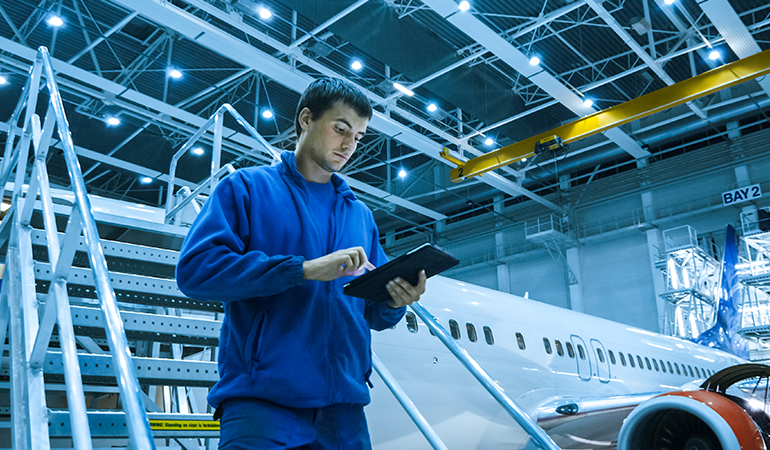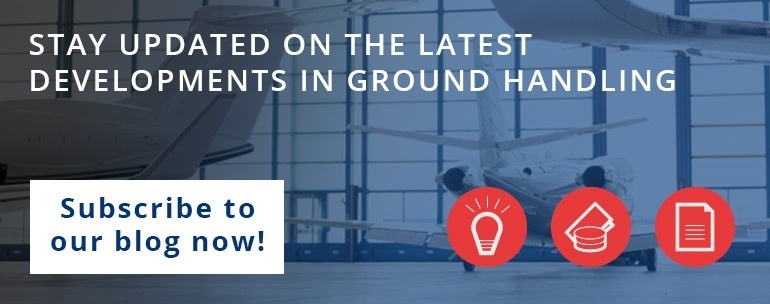Aerospace is a technology-driven discipline which has largely been locked into archaic maintenance practices and technologies, practices which are largely unchanged over the course of the last six or seven decades. Visual inspections on aircraft which are roughly the length of a football field can take hours, and it is impossible to fully inspect the surface of the aircraft. There is no way the human eye can take in all of the countoures of the surface, or identify problems below the surface. Likewise, mitigating waste in the supply chain is always imperative to meet the bottom line, but human error is just one keystroke away. What can be done to mitigate human error, identify problems and deficiencies with better accuracy and consistency, and assist the most valuable piece of aircraft maintenance, the human technician? There are a number of emerging technologies which are poised to make air travel safer, technical work faster, and improve the bottom line. Here are a few and the contributions they are poised to make.
Robotics: to eliminate repetitive tasks speed up processes
Robotics has been a mainstay of manufacturing for many years now. It is an excellent solution where monotonous yet precise work needs to be done over and over. A great example of this is spot welding body components on automobiles; the parts come down an assembly line at the same speed and location all day long. Robotics allows perfectly formed and consistent welds to be applied to a particular component all day, every day.
That being said, robotics have come a long way since then. They are used in all sorts of manufacturing and logistics (i.e., warehouses and factories), but their real level of capability is yet to be fully tapped.
First and foremost, let’s clear up a distinction here: we are not tackling drones in this particular section. While drones are being developed and are in the process of implementation, they are not representative of the robotics being developed for aircraft inspection.
NDT Solutions has developed an inverted robot which uses a track-based system to systematically transit the skin of the aircraft, inspecting each square inch of skin over the entire surface.
The Invertrac employs a suction apparatus which allows the robot to hold tight to the skin and inspect for surface and subsurface cracks, corrosion, impact damage, and lightning strikes. Since it has the ability to inspect the subsurface, it does away with much of the necessity of dismantling components to access structural components in question.
NDT Solutions is not the only manufacturer with an eye on robotics for surface inspections. Reckon Point, Inc., is a start-up located in San Antonio, Texas, which is in the process of developing robots which employ 360 degree imaging technology. Their system was not actually intended for aviation applications, but it has generated some interest nonetheless.
Reckon Point uses advanced imaging tools to develop indoor GPS solutions. They use a combination of 3D lasers, radio frequency and magnetic sensors, and a navigation system which utilizes WiFi as a means of data collection.
Reckon Point suggests it could be used for a variety of purposes, from creating indoor maps of buildings (both indoor and outdoor), but they can also track assets.
Additive Manufacturing: to get required parts quicker and with less emissions
Additive manufacturing, more commonly known as 3-D printing, is gaining a lot of traction in the aviation and aerospace maintenance industry. However, the reasoning is at least two-fold: first, parts can be manufactured in place, speeding up the supply process considerably. Second, emissions from the logistics chain can be reduced by a whopping 75%!
First, let’s look at the benefits of additive manufacturing in regards to the parts themselves.
One of the greatest successes in 3-D printing is the ability to replicate just about any three-dimensional item exactly, and to do so from a number of different materials. The interesting thing about aviation and aerospace is that many times the aircraft and airframe itself ends up outlasting parts manufacturers and suppliers, and sometimes the manufacturer itself. Take the U.S. Air Force’s B-1B Lancer for example. Rockwell has long since been defunct, yet the B-1B remains a key figure in the inventory. Many of the sub-contracted parts manufacturers have also become defunct, making it very difficult to procure parts for the maintenance-intensive aircraft. Also, due to high demand, the parts are very expensive. Many of the hard-to-find parts, such as interior trim panels, can easily be made on-site for pennies on the dollar to sourcing OEM parts.
Outside of niche military markets, there are still tremendous benefits towards air carriers. Many air carriers, particularly smaller ones, still operate legacy aircraft, or legacy models of modern aircraft (Boeing 737 comes to mind). Parts for older aircraft are sometimes hard to come by, parts like trim panels, seat trays, windows, flight deck switches, and even aircraft shells, just to name a few.
If it’s any indicator of the potential in 3-D, there are some significant financial backers supporting developers in the arena. Arevo, a startup in the Bay Area which made its mark creating printed bicycle frames. Bike frames must be very light yet absorb and distribute heavy weight and shock well, i.e., strong and light. Airbus Ventures is backing Arevo, primarily with the purpose of designing and manufacturing eVTOL aircraft parts. While they are confident in their processes strength and ability to be used in aircraft manufacturing, since composites have proven to be extremely strong and durable, the regulatory timeframe for aircraft part certification is time consuming.
British Airways sees the merit in the process for the same reason that Airbus Ventures does: it saves a lot of money on the logistics, not to mention time. BA plans to locate printers at airports all along their routes, which will sharply reduce down time, and logistics cost. Many of the large airframe components, like leading edge panels for control surfaces, This may cost thousands of dollars to ship via freight, and exposes the parts to risk of damage in transit. These issues are null when parts are produced on site. One variable which will be fully nullified is the unfortunate reality of wrong parts or ill-fitting parts being shipped, received, and then returned.
Blockchain: to track individual parts
We have written on this topic in the past, it is coming to light with increasing frequency. As with any and all business, the bottom line is always formed in the relationship of production and profit with all of the variables of overhead. Third parties are necessary entities in the brokerage process which ensure all parties are on the same sheet of music (an overly simplified analysis). For this service, they require an anything-but-nominal fee.
Perhaps Blockchain’s most alluring feature is the ability to create highly secure databases, where all transactions are recorded securely as a ledger in the chain. Once created, they are read-only and linked forever to the creator of the ledger.
In recent news, a conglomerate of seven aerospace companies are joining forces to form the “MRO Blockchain Alliance”, which should go live anytime. The concept is to improve visibility of their parts over the entire lifecycle of the part.
The impetus for this is the shear magnitude of aerospace parts. There are some 25 billion parts processed annually in the MRO industry, from around 20,000 suppliers. To add to this, around 3 billion new parts enter the market annually. As of now, there is no single-source method of tracking the parts, nor has there in the past been a system with enough capacity to track items of this magnitude. Blockchain, though, offers that kind of capacity and security protocols which have not been previously available.
Augmented Reality: to train the next generation of mechanics
This one is great. Gulf Air is pioneering a tool using augmented reality (AR) goggles to project holographic images of an aircraft. Rather than bringing prospective mechanics to a schoolhouse aircraft, the aircraft can now be brought to them in nothing more than a pair of goggles.
There are several significant drawbacks in operators using retired aircraft maintenance training. First and foremost, it still has to be stored somewhere. Operators using more than one airframe may need to multiply necessary space for maintenance trainers.
Next, they are out of date. When propulsion systems change between models, so do control linkages, auxiliary power systems, and locations of components, as well as removal and replacement of said components. By using AR, technicians will “operate” on modern aircraft exactly as they are in their fleets. Operators will also be able to lose their defunct trainer aircraft.
Conclusion to emerging technologies in ground hanDling
Technology is changing the MRO game, from drones for aerial inspections, to robotics for external inspections and mapping, to augmented reality for system familiarization and training. Not only do these tech advancements aid in alleviating human error, but they improve efficiency and significantly reduce cost overhead. And this is just the beginning; Blockchain, for instance, is still an emerging technology yet it is poised to change the entire logistic landscape for aviation maintenance. Robotics and drones are revolutionizing exterior inspections by covering 100% of the exterior where human inspections could never guarantee total coverage; it is just not possible. The future is bright for aircraft maintenance, and these technologies are just the beginning.
You want to stay updated on future articles and new topics? Subscribe to our blog for free!



Comments